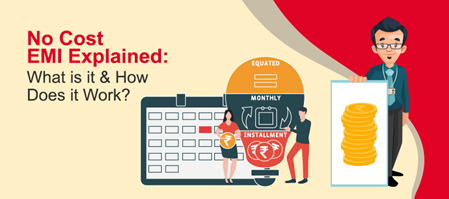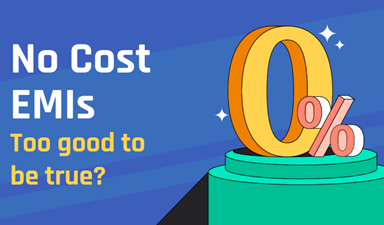No Cost EMI: A Consumers' Guide
- Akshat Agarwala
- Feb 26, 2024
- 4 min read
Updated: May 21
In this article, we will explore a common question for consumers: when buying things like a phone, clothes, or shoes, should we pay in full with cash or opt for monthly instalments known as EMI? The idea of EMI is relatively newer compared to the traditional method of taking loans to make purchases.
A recent introduction to EMI is the "no-cost EMI," also called "no-interest EMI" or “Zero-Cost EMI.” Figuring out if it is truly zero-cost can be tricky. It is important to realize that nothing in this world is entirely free. Zero-cost EMI isn't really zero-cost; someone is always covering the expenses, whether it's consumers being led to believe it is genuinely free or someone else taking the burden of cost. Understanding how this works is crucial.
The Reserve Bank of India (RBI) has issued notices that expose the misconception about no-cost EMI schemes. According to a 2013 circular, zero percent interest or no-cost EMI is almost non-existent. Experts reveal that the interest amount is included in the product's price in these schemes. Retailers and lenders might offer loans with zero interest but then sell goods or services at higher prices. Despite this, no-cost EMI schemes remain popular among users.
There are 3 main ways of implementing no-cost EMI:
Equating Discount to Interest on EMI: In this approach, the retailer omits any discount component from the price offered to the EMI seeker. For instance, if a product is available at a discounted rate to regular customers, the no-cost EMI seeker will see it at its regular price.
Incorporating Interest into the Final Price: Let's envision purchasing a TV valued at Rs. 60,000. When nearing checkout, you encounter the "Zero-Cost EMI" option, allowing payments in instalments of Rs. 10,000 over 6 months. To grasp the background of this payment process, let's assume we obtain a bank loan of Rs. 60,000 at a 10% interest rate, resulting in Rs. 3,000 interest over 6 months.
Now, considering a regular one-time payment, the TV's actual cost would be Rs. 57,000. However, when opting for zero-cost EMI, the total expense becomes Rs. 60,000. It's crucial to note that this entire process occurs in the backend, where prices vary based on the customer's chosen payment method (one-time payment, EMI, or no-cost EMI).
In summary, this implies that the actual interest the customer would have paid is essentially embedded in the product price itself, expressed as Final Price = Actual Price + Interest.
Processing Fee: Another method to implement no-cost EMI involves a processing fee. Consider you're buying a product worth Rs. 9,000, and you choose the zero-cost EMI option. In this case, a processing fee of, let's say, Rs. 500 is applied to your payment. Unlike charging interest, this fee is intended to contribute to covering the interest costs. Upon calculation, if you take a Rs. 9,000 loan for a 6-month period, paying a processing fee of Rs. 500, which equals Rs. 1,000 annually, the effective interest rate surpasses 10%. Essentially, the bank recovers its interest through the processing fee rather than charging interest directly. While a Rs. 500 processing fee might seem insignificant on a Rs. 9,000 purchase, its impact is substantial when viewed as an interest rate.
How does no-cost EMI actually work?

We started this article out by stating that nothing in this world comes for free. Somebody always bears the burden of cost, and that could be the company selling the products itself. It happens quite frequently that the company selling the product decides to bear the interest amount to be paid by the bank. Why do they do this? Simply put, they aim to encourage people to purchase their products, especially during peak periods like festival sales when product demand is high. This collaboration typically occurs with a bank, where the bank benefits by disbursing large loans, and the company selling the products covers this cost. In instances where there are no processing fees, hidden charges, and no interest, it may be a zero-cost EMI for you specifically, but not universally, as someone is still shouldering the expense of that interest.
What is the optimal choice for us as consumers?
The most advantageous option is to follow the previous scenario, particularly when we already have the entire amount to be paid. Let's illustrate this with an example: suppose we purchase a TV priced at Rs. 60,000 with a zero-cost EMI offer, perhaps during a festive sale. In this case, the actual cost for a one-time payment of the TV remains Rs. 60,000. Even if we choose the No-Cost EMI option without processing fees or hidden charges, the cost still amounts to Rs. 60,000. The arrangement involves paying the amount in monthly instalments of Rs. 10,000 over 6 months.

The wise approach here is to possess the Rs. 60,000 in advance and still opt for the No-Cost EMI option. Why? Because we could invest that Rs. 60,000 in a short-term asset such as a Fixed Deposit or a corporate bond, ensuring a favorable return annually. Assuming a 5% annual return, it means earning Rs. 3,000 for a year, equivalent to Rs. 1,500 for 6 months. Consequently, by choosing the No-Cost EMI option, you would have earned Rs. 1,500, and the effective cost of the TV would be Rs. 60,000 - Rs. 1,500 = Rs. 58,500. The notable advantage is that this strategy becomes more lucrative as you apply it to higher-priced products. For example, if instead of a Rs. 60,000 TV, you bought a car worth 10 Lakh and applied the same method, you would have gained a lot more relative to the interest gained on the Rs. 60,000 purchase by converting that 10 Lakh into short-term assets for investing. This approach provides a comprehensive solution on whether to make a cash purchase or opt for the EMI route.
-Akshat Agarwala



Comments